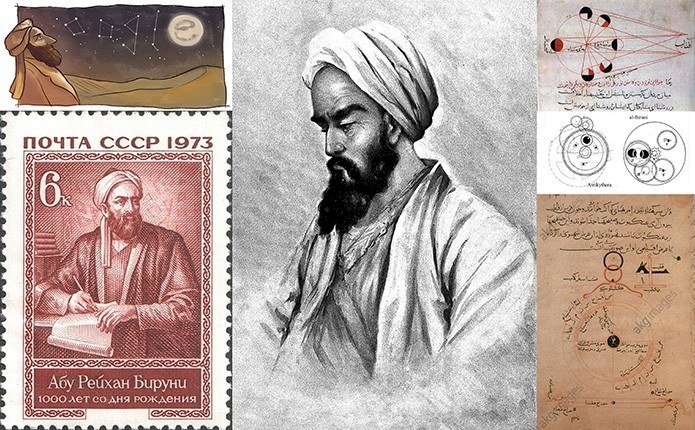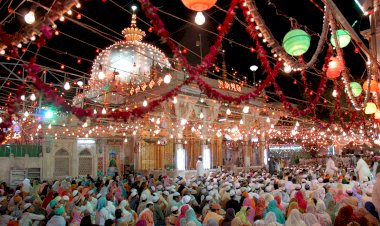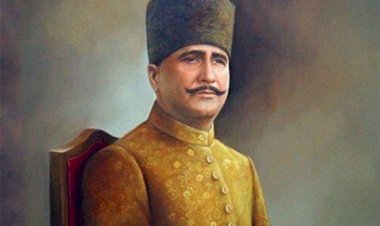Abū Rayḥān Al-Bīrūnī: A Polymath of 11th Century
Abū Rayḥān Muḥammad ibn Aḥmad Al-Bīrūnī was an Iranian Muslim scholar and polymath during the Islamic Golden Age. Throughout his life, al-Bīrūnī dedicated himself to producing knowledge by travelling and meeting erudite scholars. He is famously known as the ‘founder of Indology', 'father of comparative religion', 'father of modern geodesy' and the first anthropologist. He is also known as a historian and linguist. Al-Bīrūnī wrote more than 140 books in different fields as he contributed to many scientific fields, especially in Religionswissenschaft (Scientific Study of Religion). He provided necessary methods and proper guidelines for future scholars who wish to be part of similar studies. His works show that he was developing a methodology for the scientific study of religions.
Al-Bīrūnī was a Sunni theologian and very critical of the Mu’tazilah, especially criticizing al-Jāhiz and Zurqan. He also refuted Avicenna for his views on the eternity of the universe. In June 1974, the UNESCO Courier magazine published a special issue on him titling ‘A universal genius in Central Asia a thousand years ago’ and described him as an astronomer, historian, botanist, pharmacologist, geologist, poet, philosopher, mathematician, geographer, and humanist.[1]
Biographical Sketch
Al-Bīrūnī was born on the 3rd of Dhu al-Ḥijjah/ 4th of September 362/973 on Thursday at the outer district (Birūn) of Kāth, the capital of the Afrighid dynasty of Khwārizm in Central Asia. Khwārizm is also known as Khorasam or Chorasmia, where Al Bumasar, Al Fraganus, Al Fārābi, Avicenna, Omar Khayyām, Al Khwārizmi, and many other renowned scholars were born. Scholars have differed on the exact birthplace of al-Bīrūnī. Some said that he was born in Birūn in Sindh, while the Soviet scholars said that he was born in Khiva in Uzbekistan and others said he was born in Khwārizm in Central Asia. Al-Bīrūnī is sometimes called “al-Khwārizmi”, though he never used this word.
There is no historical record of his burial place. He died in Rajab 440, on the 13th of December 1048, in Ghaznah of today’s Afghanistan. According to some scholars, he lived until 442/1050 because he wrote his book “al-ṣaydalah fi al-ṭib” this year.
Early Life and Education
There is no further information about his ancestors. He grew up under his mother due to his father’s death in his early childhood. Al-Bīrūnī served his mother by cutting branches from the jungle and selling them. Scholars believe that al-Bīrūnī went through the regular school system of the time, the maktab (elementary school) and madrasah (religious school), and studied Islamic subjects such as tafsīr, ahādīth, Arabic language and grammar, fiqh, history etc.[2]
In his early childhood, he was interested in natural sciences as he observed plants, flowers, birds, and stars. The extreme thirst for knowledge brought him to an unknown Greek scholar, his first teacher from whom al-Bīrūnī learned Suriani and Greek languages.
Afterwards, he studied Mathematics and astronomy from Abū Naṣr Manṣūr Ibn ʿAli, who was a member of the royal family at Kāth. Later, he studied science from ʿAbd al-Ṣamad Ibn ʿAbd al- Ṣamad. Al-Bīrūnī was widely known as “Abū Rayḥan” in his 23rd of age because of his vast knowledge.
Travels and Academic Journey
In 995 A.C., the ruler of Jurjāni attacked Kāth and then al-Bīrūnī was exiled to “Rayy” in Iran, a famous centre for astronomy at that time. He made a good relationship with al-Khujandi, a renowned astronomer and exchanged observations with him. Even in the difficulties of Rayy, within three years, al-Bīrūnī benefitted much from their observatory. He developed a trigonometric method for measuring the earth and wrote his first book from there.
In 997 A.C., he returned to Kāth and observed a lunar eclipse that Abū al-Wafa observed in Baghdad. Thereby al-Bīrūnī’s identified the time difference between Kāth and Baghdad. Later, he visited the Samanid court at Bukhāra and Isfahān of Gilanand, which helped him collect a lot of information for research. He also met AbūʿAli Ibn Sīna, who was only 18 at that time. Both were brought to the court and treated well by the ruler.
Afterwards, he went to Jurjān in 390/999 at the invitation of Sultan Shams al-Maʿali Ibn Qabūs. He completed his reputed book Kitāb al-Athār (al-Athār al-Bāqiya ʿan al-Qurūn al-Khāliya) and dedicated it to the Sultan. Later, al-Bīrūnī dedicated another book, Risālah-i-Tajrid al-Shaʿat, to the same Sultan. It was also in Jurjān where al-Bīrūnī started his preliminary works on the measurement of the earth’s latitudes.[3]
In 1009 A.D., after living ten years in Jurjān, al-Bīrūnī left for Khwārizm by receiving the invitation from the new Ma’munid ruler, Abū al-Ḥasan ʿAli. He wrote his famous book al-Tafhīm li availiṣina’ati al-tanjīm from there.
In 1017 A.D., Sultan Mahmūd invaded Khwarezm and carried off scholars and respected people to India/Afghanistan. Al-Bīrūnī was taken to Ghaznah, the capital of the Ghaznavid empire, because of his political involvement. Among the scholars were the physician Abu al-Khajr Ibn Khammar and Abū Nasr ibn Irāq. Al-Bīrūnī got appointed as court astrologer of Mahmūd, and later, he accompanied the invading hordes of Mahmūd Ghazni to the Indo-Gangetic valley as a freelance observer, where he became interested in Hinduism and Indian culture. With extensive travelling experience he gained from places such as Northern India and Punjab, communicating with Brahmins in the Sanskrit language, he wrote the classic account of the country and its people in Arabic, entitled “Kitāb al-Hind” in 1030 AD.
After Mahmūd, in the reign of Masūd and Mawdūd, al-Bīrūnī was treated well and got great esteem and respect like every other scholar. He dedicated his magnum opus to Masūd and named it “Qanun al-Masūdi”. Mawdūd was the last Sultan al-Bīrūnī served, and he dedicated his book “Kitābal-Dastūr” to the Sultan.
In his 68th age, several problems broke out in the court of the Sultan. So, he went out of the court as he wished for the rest of his life with peaceful moments. He spent his last eight years writing books and sharing knowledge.
Intellectual Contributions
Al-Bīrūnī has left a great legacy in the field of scholarship. His works include a wide range of subjects, from applied and theoretical mathematics to pharmacology, geology, mineralogy, and history. He was a polymath of the Islamic Golden Age, making significant breakthroughs as a philosopher, mathematician, astronomer, theologian, encyclopaedist, linguist, poet, humanist, historian, pharmacist, botanist, physician, anthropologist, traveller, and geographer. He published a total number of 146 books.
Al-Bīrūnī is generally known as one of the greatest scientists of Islam. As George Sarton comments on al-Biruni in his “Introduction to the History of Science”, he is “one of the very greatest scientists of Islam, and all considered, one of the greatest of all time.”
In the field of the sciences, Ghulam Rabbani Aziz notes some of al-Bīrūnī's major contributions as follows:
(1) Trisection of an angle, and solution of some complex problems without the use of protractor and scales.
(2) Accurate determination of latitude and longitude of a large number of places.
(3) Pointing to the existence of the American continent.
(4) Putting forward his theory that the Sind valley was under water sometime in the past, which later changed into dry land following some geographical changes.
(5) Explaining the flow of springs on the principle that water finds its own level.
(6) Determination of specific gravity of 18 precious stones and metals.
(7) Providing proof that light travels at a much faster speed than sound.
(8) Explaining the forces of gravity.
(9) Throwing light on gravitational force.
(10) Devising methods to identify a number of precious stones.
(11) Explaining the phenomenon of fire visible at the time of a sun eclipse.
(12) Providing useful information and views about the height of various trees.
(13) Discussion on the issue of whether the earth revolves around its axis or not.
(14) Explaining on the universal law of nature that flowers always have 3, 4, 5, 6, or 8 petals and never 7 or 9.
(15) Determination of the circumference and diameter of the earth by using spherical trigonometry.
(16) Determination of the sun's declination and zenithal movement.[4]
Conclusion
In this article, the life of Abū RayhānAl-Bīrūnī and his major contributions has been briefly described, along with a sketch of the sociological and political scenario during his time. The intellectual background of al-Bīrūnī shows that the period was scholastically vibrant. Even though the political situations of Muslim countries were in chaos, the rulers kept supporting the scholastic community and their contributions. The vast knowledge of al-Bīrūnī in dozens of academic fields made him immortal in the scholastic world.
(Mohammed Anas P is Lecturer at Sidheeq Moula Arabic College, Lakshadweep)
[1] The UNESCO Courier, 1974: 1.
[2] M.Kamiar. 2009. Brilliant Biruni: A Life story of Abu Rayhan Mohammad Ibn Ahmad .
[3] Kamar Oniah, Early Muslim Scholarship in Religionswissenschaft, 31.
[4] Kamar Oniah, Early Muslim Scholarship in Religionswissenschaft, 17-18.
Disclaimer
The views expressed in this article are the author’s own and do not necessarily mirror Islamonweb’s editorial stance.
























Leave A Comment